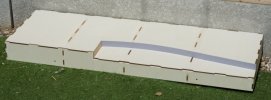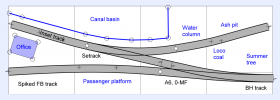I finished the baseboard today. This is from a kit by Grainge and Hodder, 1200 x 400 mm.
Well, not quite. I spent last week altering the baseboard. The basin is now broad enough to take a full-size model of 60 foot barge from the Chelmer and Blackwater Navigation, and the baseboard top is deep enough to let me plant my waiting shelter on the passenger platform.
Personally I wouldn't as it would make the baseboard larger and more awkward to store. I'd try and keep within the 1200 x 400mm.
I do agree with these sentiments, but I want to keep the model on show and I think it is worthwhile to try to make it blend into the domestic setting.
Here are some photos of the new work. The main thing is, I am trying to make something light enough to carry in one hand, rigid enough to hold the track and the scenery, and strong enough to withstand normal handling. I don't want to stand on the model.
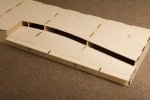
I have cut a strip off the baseboard top to move the rear of the basin backwards, and added the offcut from the front of the baseboard to bring the front of the basin forwards. The total increase is barely 45 mm but the basin now has more stature. It doesn’t look like something of nothing any more.
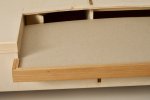
I also cut some slots into the frame underneath the rear edge so I can slot in a sheet of something to represent the water. The front trim (to be fixed later) is from a picture frame bought in a charity shop. I could never do a mitre corner this good!
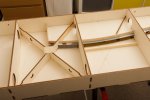
The bottom of the basin is the cardboard artwork from the same picture frame.
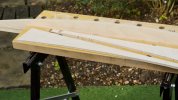
The rear extension is from two pieces of 4 mm ply, these glued together on the waste side, then cut to line with the jigsaw and planed smooth. The offcuts (glued together forever) are in the foreground.
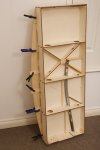
The top panel is 20 mm broader than the bottom panel. The top panel is pinned and glued onto the top of the baseboard, and packing pieces are glued in underneath it.
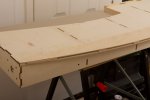
Then the bottom panel is glued into place.
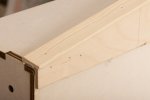
The construction is completed with a strip of D moulding pinned and glued.
I borrowed this sort of cellular design from an extremely heavy P4 baseboard I saw years ago, but I used thinner materials and enclosed the voids on all four sides. The result does seem to be much stronger than its individual parts.
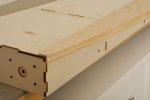
I am hoping a curving backdrop panel will give the model a more gentle appearance; it might end up in the living room one day. Meanwhile, the curve does not have sharp corners to snag on clothing, and this will be useful in the hobby room where the model sits with its front facing a wall, no backscene and its back overhanging the furniture.


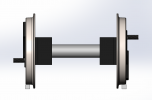
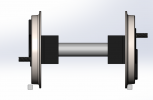
 )
)